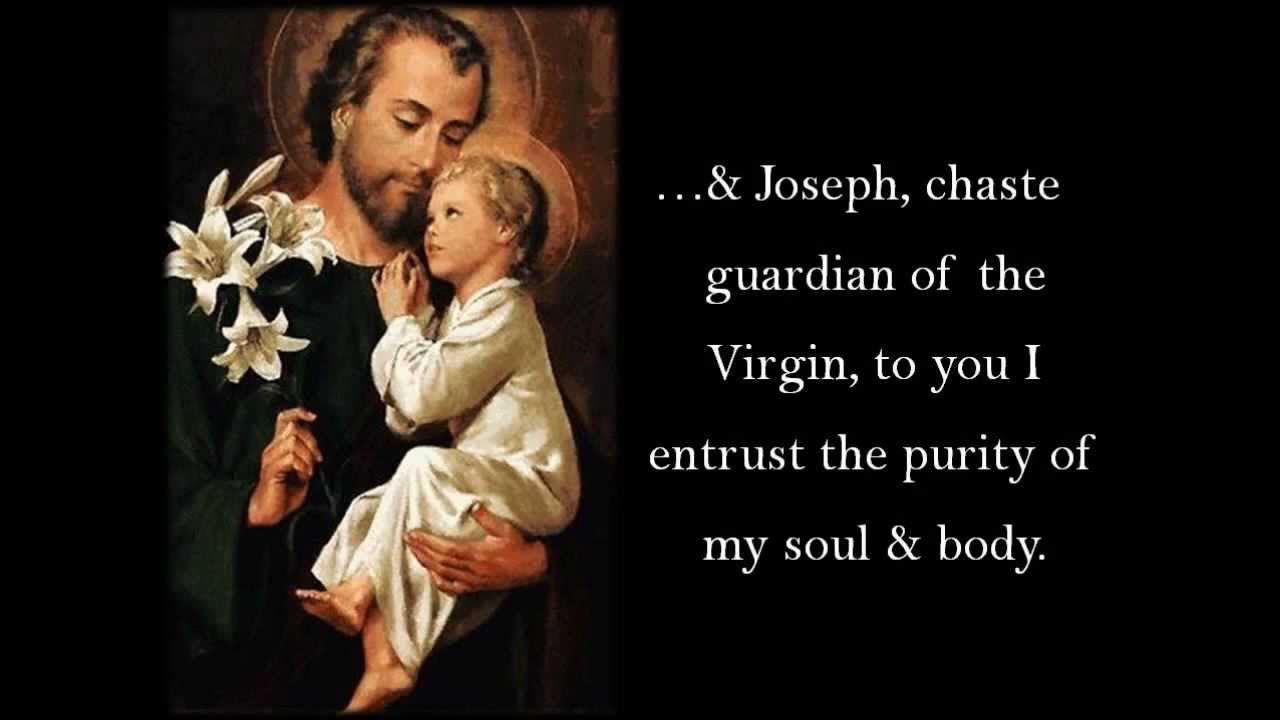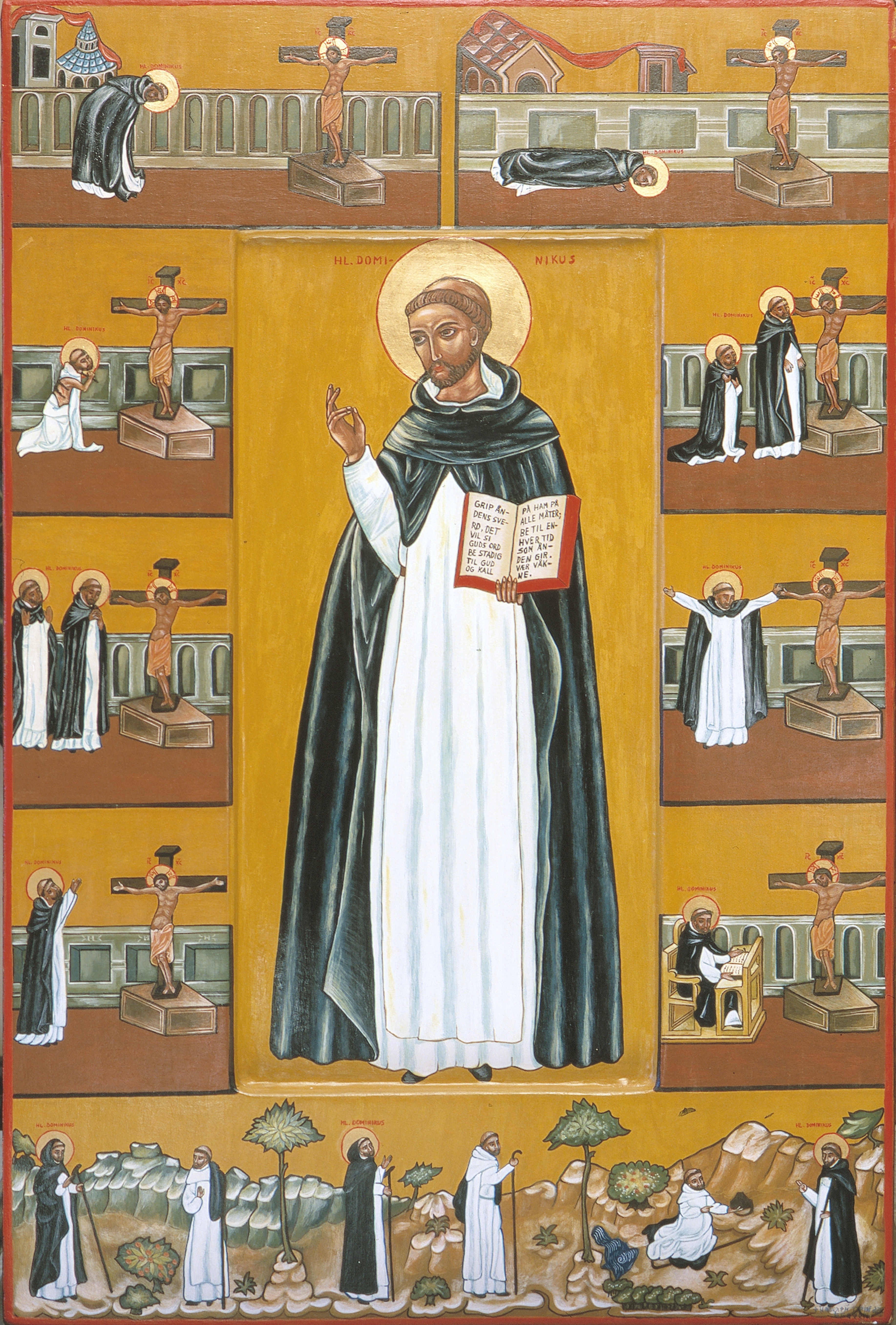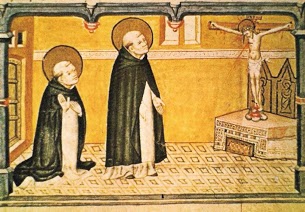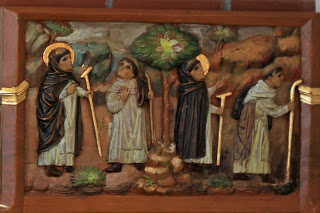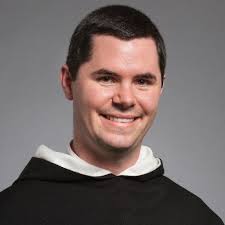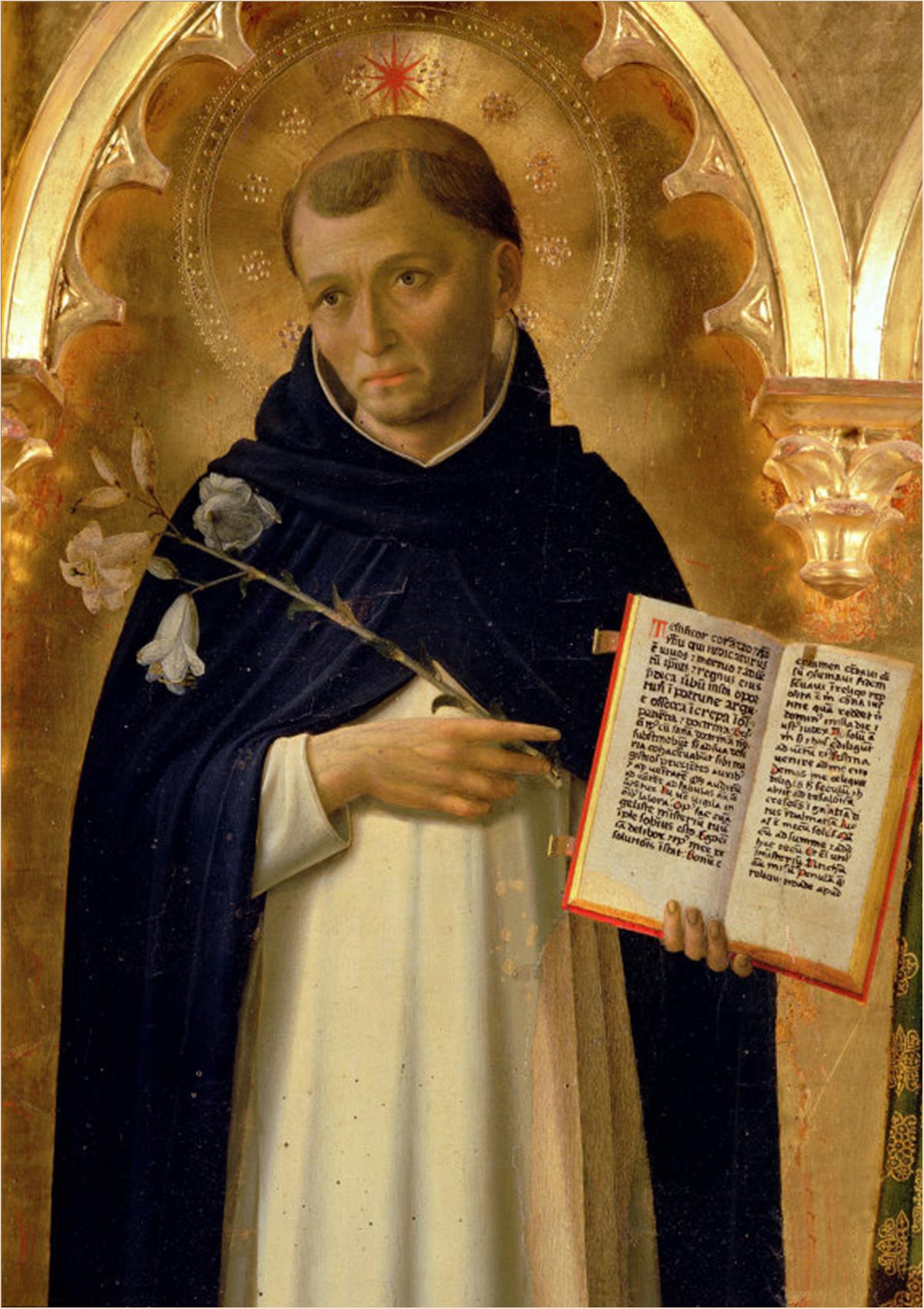
-side panel, the Perugia altarpiece, depicting Dominic, by Fra Angelico, 1436.
“Zeal must be met by zeal, humility by humility, false sanctity by real sanctity, preaching falsehood by preaching Truth.” – St Dominic
Good thinking leads to good action; bad to calamity/catastrophe. One to life, the other to death. There is such a thing as objective moral truth. A basic premise of philosophy, even outside of theology, is “truth cannot contradict truth”. Ask the victims of the Nazis, etc. An American heresy is that all thought is merely innocuous and is equally good and valuable. Really? Really? 🙁
Dominic, founder of the great order of preaching friars which bears his name, was born in the year 1170 at Calaruega, Castile, Spain, of a noble family with illustrious connections. His father, Don Felix de Guzman, held the post of royal warden of the village; his mother, a woman of unusual sanctity, was to become Blessed Joan of Aza. Very early it was decided that Dominic should have a career in the Church. His call was so evident that while he was still a student, Martin de Bazan, bishop of Osma, appointed him canon of the cathedral, and the stipend he received helped him to continue his studies. Dominic’s love of learning and his charity are both exemplified in a story of his student days. He had gathered a collection of religious books inscribed on parchment; these he greatly treasured, but one day he sold the whole lot that he might give the money thus obtained to some poor people. “I could not bear to prize dead skins,” he said, “when living skins were starving and in need.”
At the age of twenty-five he was ordained and took up his duties. The chapter lived under the rule of St. Augustine, and the strict observance gave the young priest the discipline that he was to practice and teach to others all his life. Someone who knew Dominic at this time wrote that he was first of all the monks in holiness frequenting the church day and night, and scarcely venturing beyond the walls of the cloister. He was soon made subprior, and when the prior, Diego d’Azevado, became bishop of Osma. about 1201, Dominic succeeded to his office. He had then been leading the contemplative life for six or seven years.
When, two years later, the bishop was appointed by the King to go on an embassy to negotiate a marriage for the King’s son, he chose Dominic to accompany him. On the way, they passed through Languedoc, in southern France, where the Albigensian heresy was winning many adherents. Albigensianism, Manicheaism, Catharism are all names for basically the same heresy: namely, that there are two gods, a good god who created the spiritual realm, and an evil god who created the physical. This type of thinking leads married couples to stop having children and the “perfecti”, the elect, the most spiritually pure to starve themselves to death. This type of thinking leads to the destruction of society. Inspired in part by the Persian prophet Mani (216-276 AD), it is a major form of Gnosticism, another heresy, for another time. The host at an inn where they stopped was an Albigensian, and Dominic spent a whole night in discussion with Dominic. By morning he had convinced the man of his error. From that day, it appears, Dominic knew with certainty that the work God required of him was an active life of teaching in the world.
The ambassadors returned to Castile after their mission was accomplished, then were sent back to escort the young woman to her future home, but they arrived only to assist at her funeral. Their retinue returned to Castile, while they went to Rome to ask leave of Pope Innocent III to preach the Gospel to the infidels in the East. The Pope urged them to stay and fight against the heresy which was threatening the Church in France. Bishop Diego begged to be allowed to resign his episcopal see, but to this the Pope would not consent, though he gave him permission to stay two years in Languedoc. They paid a visit to St. Bernard’s monastery at Citeaux, whose monks had been appointed to go on a mission to convert the Albigensians. Don Diego put on the Cistercian habit and almost at once set out with Dominic and a band of preachers.
Albigensian doctrine was based on a dualism of two eternally opposing principles, good and evil, all matter being regarded as evil and the creator of the material world as a devil. Hence the doctrine of the Incarnation was denied, and the Old Testament and the Sacrament rejected. To be perfect or “pure” a person must refrain from sexual relations and be extremely abstemious in eating and drinking. Suicide by starvation was by some regarded as a noble act. In its more extreme form Albigensianism thus threatened the very existence of human society. The rank and file did not attempt such austerity, of course, but the leaders maintained high standards of asceticism, in contrast with which the easy-going observance of the Cistercian preachers away from home looked far from saintly. Dominic and Diego now advised those who had been in charge of the mission to give up their horses, retinues, and servants. Also, as soon as they won a hearing, they were to use the method of peaceful persuasion instead of threats. The way of life Dominic enjoined on others he was the first to follow himself. He rarely ate anything but bread and soup; if he drank wine it was two thirds water; his bed was the floor, unless-as sometimes happened-he was so exhausted that he lay down at the side of the road to sleep.
The missionaries’ first meeting with the heretics took place at Servian in 1206, where they made several conversions; afterwards they preached at Carcassone and neighboring towns, but nowhere did they meet with unusual success. At one public debate the judges submitted Dominic’s statement of the Catholic faith to the ordeal by fire, and three times, it is recorded, the parchment was left unharmed by the flames. The heresy, supported as it was by the great spiritual and temporal lords of the country, had a strong hold on the populace, who seemed unmoved either by preaching or miracles. Diego, disappointed with the results, returned to Osma, leaving Dominic in France.
Women exerted great influence in the Middle Ages, as now, and Dominic was struck by their share, perhaps most, “the hand that rocks the cradle rules the world!”, in the propagation of Albigensianism. He also observed that many Catholic girls of good family were exposed to wrong examples in their own homes or else were sent to Albigensian convents to be educated. On the feast of St. Mary Magdalen in 1206 he had a vision which led him to found a convent at Prouille, in the diocese of Toulouse, to shelter nine nuns, who had been converted from heresy. He wrote for them a rule of strict enclosure, penance, and contemplation, with the spinning of wool for their manual occupation. A house was founded a little later, in the same locality, for his preaching friars, whom he placed under a strict rule of poverty, study, and prayer.
In 1208, after the murder of a papal legate, Pope Innocent called on the Christian princes to suppress the heresy by force of arms. The Catholic forces were led by Simon de Montfort, the Albigensian by the Count of Toulouse. Everywhere Montfort was victorious, but he left behind him destruction and death. Dominic had no part in this terrible civil war. Courageously he continued to preach, going wherever he was called, seeking only the good of those who hated him. Many attempts were made on his life, and when he was asked what he would do if caught by his enemies, he answered, “I would tell them to kill me slowly and painfully, a little at a time, so that I might have a more glorious crown in Heaven.” When Montfort’s armies approached where he was preaching, he did all he could to save human life. Among the crusaders themselves, many of whom had joined the Catholic side for the sake of plunder, he discovered disorder, vice, and ignorance. Dominic labored among them with as much diligence and compassion as among the heretics. The Albigensian military forces were finally crushed in the battle of Muret, in 1213, a victory which Montfort attributed to Dominic’s prayers. The victor was not satisfied, however, and, to Dominic’s great distress, kept up for five years longer a campaign of devastation, until at last he was killed in battle.
Dominic had no illusions as to the righteousness or efficacy of establishing orthodoxy by armed force, nor had he himself anything to do with the episcopal courts of the Inquisition which were set up in southern France to work with the civil power. He never appears to have approved of the execution of those unfortunate persons whom the courts condemned as obdurate. His biographers say that he saved the life of a young man on his way to the stake, by assuring the judges that, if released, the man would die a good Catholic. The prophecy was fulfilled some years later, when the man entered the Dominican Order. Dominic rebuked the bishop of Toulouse for traveling with soldiers, servants, and pack-mules. “The enemies of the faith cannot be overcome like that,” he said. “Arm yourself with prayer instead of a sword; be clothed with humility instead of fine raiment.” Offered a bishopric three times, Dominic each time declined, knowing well that his work lay elsewhere.
He thus spent nearly ten years in Languedoc, with headquarters at Prouille, leading the mission and directing the work of his special band of preachers. His great desire was to revive a true apostolic spirit in the ministers of the altar, for too many of the Catholic clergy lived for their own pleasure, without scruple. He dreamed of a new religious order, not like the older ones, whose members led lives of contemplation and prayer in isolated groups, and who were not necessarily priests. His men would join to their prayers and meditation a thorough training in theology and the duties of a popular pastor and preacher; like the earlier monks, they would practice perpetual abstinence from meat and live in poverty, depending on alms for subsistence. They would be directed from a central authority, so that they could be moved about according to the need of the time. Dominic hoped thus to provide the Church with expert and zealous preachers, whose spirit and example would spread the light. In 1214 Bishop Foulques conferred on him a benefice at Fanjeaux, and gave his episcopal approval to the new order. A few months later he took Dominic with him to Rome to attend the Fourth Lateran Council, as his theologian.
Pope Innocent III approved the convent at Prouille. He also issued a decree, which was counted as the tenth canon of the council, reminding all parish clergy of their obligation to preach, and stressing the need of choosing pastors who were powerful in both words and works. The current neglect of preaching, said the Pope, was one cause of the ignorance, disorders, and heresies then rampant. Yet Dominic did not find it easy to get formal approval for his preaching order; it contained too many innovations for sanction to be granted hastily; moreover, the council had already voted against the multiplication of religious orders. It is said that Innocent had decided to withhold his consent, but on the next night dreamed he saw the Lateran Church tottering as if on the verge of collapse; Dominic stepped forward to support it. Be that as it may, the Pope finally gave oral approval to Dominic’s plan, bidding him return to his brothers and select one of the rules already approved.
The little company which met at Prouille in August, 1216, consisted of eight Frenchmen, eight Spaniards, and one Englishman. After some discussion, they chose the rule of St. Augustine, the oldest and least detailed of the existing rules, which had been written for priests by a priest who was himself an eminent preacher. He added certain special provisions, some borrowed from the more austere order of Premontre. Meanwhile Pope Innocent died, in July of 1216, and Honorius III was elected in his place. In October of that year, after Dominic had set up a friary in Toulouse, he went to Rome. Honorius formally confirmed his order and its constitutions in December. The brothers were to be, in the words of the Pope’s bull, “the champions of the faith and the true lights of the world.”
Instead of returning at once to France, Dominic stayed in Rome until the following Easter in order to preach. He suggested to the Pope that since many of the clerics attached to his court could not attend lectures and courses outside, a master of sacred studies in residence would be very useful. Honorius then created the office of Master of the Sacred Palace, who ex-officio serves as the Pope’s personal canonist and theologian, nominates his preachers, and assists at consistories. He ordered Dominic to assume the office temporarily, and ever since it has been held by a member of the Order of Preachers. While at Rome, too, Dominic composed a commentary on the Epistles of St. Paul, much commended in his day, but, like his sermons and letters, it has not survived.
During this time Dominic formed friendships with Cardinal Ugolino and Francis of Assisi. The story goes that in a dream Dominic saw the sinful world threatened by the divine anger but saved by the intercession of the Virgin, who pointed out to her Son two figures, one of whom Dominic recognized as himself, while the other was a stranger. The next day in church he saw a poorly dressed fellow whom he recognized at once as the man in his dream. It was Francis of Assisi. He went up to him and embraced him, exclaiming, “You are my companion and must walk with me. For if we hold together no earthly power can withstand us.” This meeting of the founders of the two great orders of friars, whose special mission was to go out into the world to save it, is still commemorated twice a year, when on their respective feast days the brothers of both orders sing Mass together, and afterwards sit at the same table. Dominic’s character was in marked contrast to that of Francis, but they stood united on the common ground of faith and charity.
On August 13, 1217, the Friars Preachers, popularly known in later times as the Dominicans, first met as an order at Prouille. Dominic spoke to them on methods of preaching and urged them to unremitting study and training. He reminded them too that their primary duty was their own sanctification, for they were to be successors of the Apostles. They must be humble, putting their whole confidence in God alone; only thus might they be invincible against evil. Two days later, Dominic abruptly broke up his little band, dispersing them in different directions. Four he sent to Spain, seven to Paris, two returned to Toulouse, and two stayed at Prouille. Dominic himself went back to Rome. He had hopes that he might resign his post and set off to preach to the Tartars, but Pope Honorius would not give his consent.
The four remaining years of Dominic’s life were spent in developing the order. Honorius gave him the church of St. Sixtus in Rome as a center for his activities. He preached in many of the city’s churches, including St. Peter’s. An old chronicle tells us that a woman named Gutadona, on coming home one day from hearing him preach, found her little child dead. In her grief she lifted him out of the cradle, and carried him to the church of St. Sixtus to lay him at Dominic’s feet. He uttered a few words of fervent prayer, made the sign of the cross, and the child was straightway restored to life. The Pope would have had this miracle proclaimed from the pulpit, but the entreaties of Dominic checked him.
Large numbers of nuns were living in Rome at this time, uncloistered and almost unregulated, some scattered about in small convents, others staying in the houses of parents or friends Honorius now asked Dominic to assemble these nuns into one enclosed house. Dominic gave to the nuns his own monastery of St. Sixtus, which was then completed. For his friars he was given a house on the Aventine Hill, with the adjacent church of St. Sabina.
A house of the order had been founded at the University of Paris, and Dominic had sent a contingent to the University of Bologna, there to set up one of the most famous of his establishments. In 1218 he journeyed through Languedoc to his native Spain, and founded a friary at Segovia, another at Madrid, and a convent of nuns, directed by his brother. In April, 1219, he returned to Toulouse, and from there went to Paris, the first and only visit he paid to the city. On his way back he stopped to found houses at Avignon, Asti and at Bergamo in Lombardy. Towards the end of the summer Dominic reached Bologna, there to live until his death. In 1220 Pope Honorius confirmed his title as Master General of the Order of Brothers Preachers, and the first general chapter was held at Bologna. The final constitutions were then drawn up which made the order what it has since been called, “the most perfect of all the monastic organizations produced by the Middle Ages.” That same year the Pope charged them, along with the monks of other orders, to undertake a preaching crusade in Lombardy. Under Dominic’s leadership, a hundred thousand heretics are said to have been brought back to the Church.
Although Dominic had hoped to journey to barbarous lands to preach and eventually to achieve martyrdom, this was denied him. The ministry of the Word, however, was to be the chief aim of his great order. Those members who had a talent for preaching were never to rest, except during the intervals assigned to them for retirement. They must prepare for their high calling by prayer, self-denial, and obedience. Dominic frequently quoted the saying: “A man who governs his passions is master of the world. We must either rule them, or be ruled by them. It is better to be the hammer than the anvil.” He taught his friars the art of reaching the hearts of their hearers by animating them with a love of men. Once, after delivering a stirring sermon, he was asked in what book he had studied it. “In none,” he answered, “but that of love.”
Dominic never altered the severe discipline he had established at the start. When he came back to Bologna in 1220, he was shocked to find a stately monastery being built for his friars; he would not allow it to be completed. This strong discipline helped the rapid spread of the order. By the time of the second general chapter at Bologna in 1221, it numbered some sixty houses, divided into eight provinces. Already there were black- robed brothers in Poland, Scandinavia, and Palestine, and Brother Gilbert, with twelve to aid him, had set up monasteries in Canterbury, London, and Oxford. The Order of Preachers is world-wide and noted especially for its intellectual achievement; it has become the mouthpiece of scholastic theology and philosophy today. There are Dominican establishments adjacent to almost all the chief seats of learning, and the founder has sometimes been called “the first minister of public instruction in Europe.” The Dominicans are cloistered, but there is also a Third Order for active workers in the world, religious and lay. In contrast to most other orders within the Church, the Dominican Order, in its 800 year history has never needed to be reformed. Due to a play on the Italian “Dominicanes”, the Order of Preachers has been given the nickname “The Hounds of God”, get it? Domini-canes?! A popular symbol of the Order of Preachers is a dog with a burning torch clutched in its mouth running, setting the world ablaze for Christ.
At the close of the second general chapter, Dominic visited Cardinal Ugolino in Venice. Afterwards he fell ill and was taken to the country. He knew the end was near, and made his last testament in a few simple, loving words: “These, my much loved ones, are the bequests which I leave to you as my sons; have charity among yourselves; hold fast to humility; keep a willing poverty.” He asked to be carried back to Bologna, that he might be buried “under the feet of his brethren.” To this day, Dominicans gather in the hallways of their priories and sing the De Profundis in memory of their confreres buried under the hallway floor. I remember doing this as a novice. My most favorite time of a Dominican day. Gathered about him on an August evening, they said the prayers for the dying; at the Subvenite, he repeated the words and died; he was only fifty-six years old. The saint died “in Brother Moneta’s bed, because he had none of his own, in Brother Moneta’s habit, because he had not another to replace the one he had long been wearing.”“Do not weep, for I shall be more useful to you after my death and I shall help you then more effectively than during my life.”
Jordan of Saxony, Dominic’s successor as master-general of the order, wrote of him: “Nothing disturbed the even temper of his soul except his quick sympathy with every sort of suffering. And as a man’s face shows whether he is happy or not, it was easy to see from his friendly and joyous countenance that he was at peace inwardly.” When in 1234 Pope Gregory IX, formerly Cardinal Ugolino, signed the decree of canonization, he remarked that he no more doubted the sanctity of Dominic than he doubted that of St. Peter or St. Paul.

-“St Dominic of Guzman”, by Claudio Coello, 1685, Museo Nacional del Prado, Spain.
“Wonderful, saintly founder of the eloquent Order of Preachers,
friend of St Francis of Assisi, you were a fiery defender of the Faith,
a fighter against the darkness of heresy. You resembled a great
star, that shone close to the world and pointed to the Light of
Christ.
O Holy Priest of God and glorious Patriarch, St. Dominic,
thou who wast the friend, the well-beloved son and confidant of the Queen of Heaven, and didst work so many miracles by the power of the Holy Rosary, have regard for my intercessions.
On earth you opened your heart to the miseries of your fellow man,
and your hands were strong to help them; now in heaven your charity has not grown less nor has your power waned.
Pray for me to the Mother of the Rosary and to her divine Son,
for I have great confidence that through your assistance
I shall obtain the favor I so much desire: (mention your intentions). Amen.”
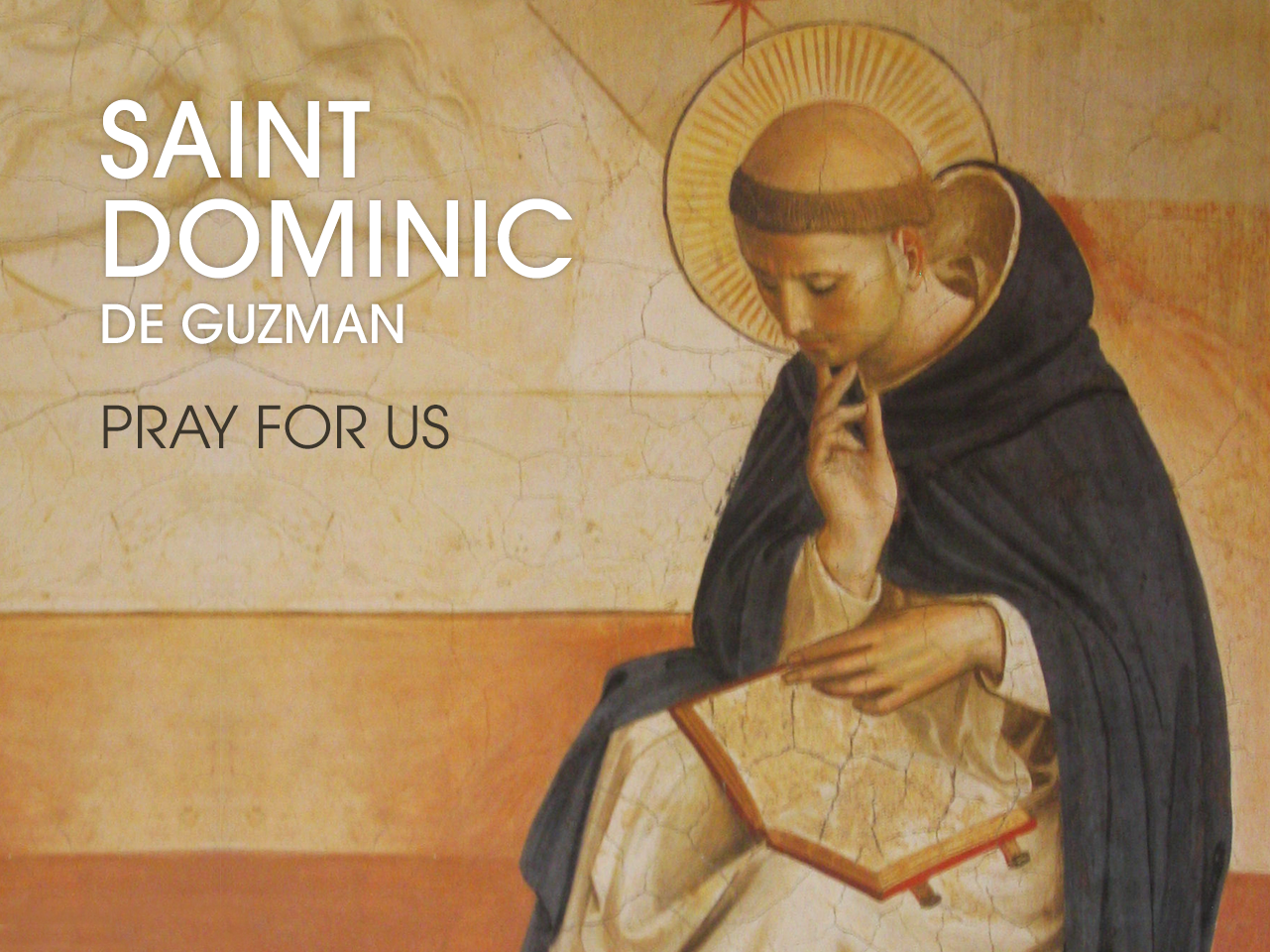
Love,
Matthew

